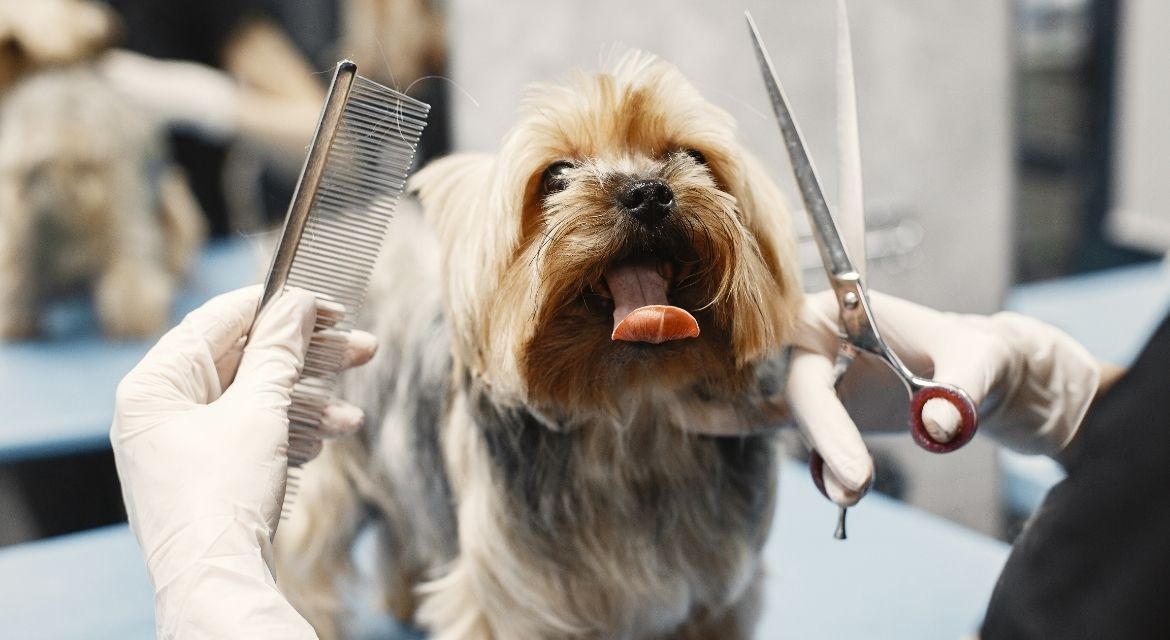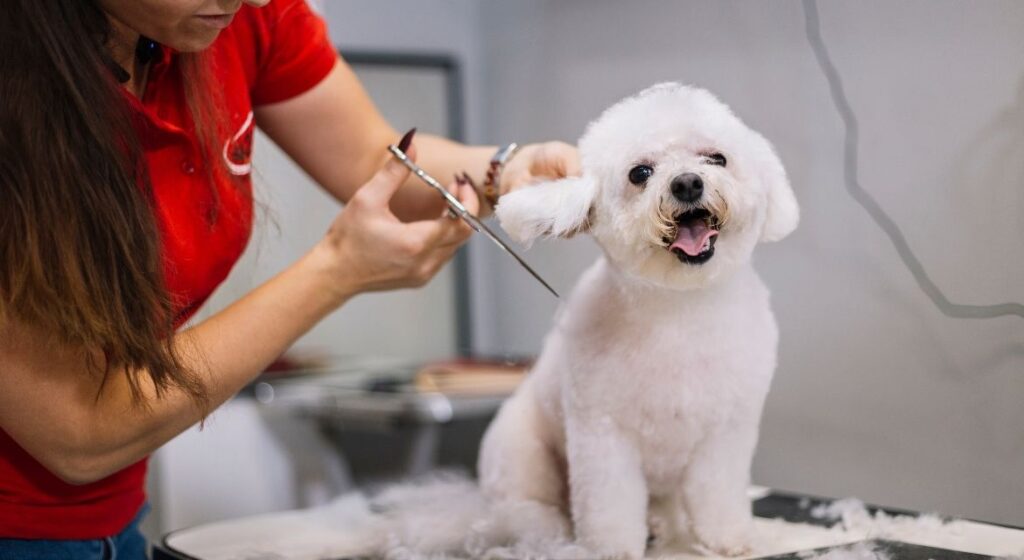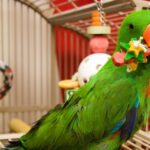 17 May
17 MayDog Grooming at Home: The Complete Guide for Dog Owners
Table of Contents
Introduction
Dog grooming at home is not just about maintaining your pet’s appearance it’s an essential part of their overall health and well-being. Regular dog grooming at home helps prevent skin problems, reduces shedding, and keeps your furry friend’s coat healthy and shiny. Beyond the physical benefits, establishing a consistent dog grooming at home routine creates valuable bonding time with your pet while saving you money on professional grooming services.
Many first-time pet owners feel intimidated by the prospect of dog grooming at home, worried about making mistakes or causing their dog discomfort. However, with the right knowledge, tools, and approach, dog grooming at home can become a rewarding and straightforward part of your pet care routine. This comprehensive guide breaks down everything you need to know about dog grooming at home, from preparation to execution, helping you become confident in your ability to keep your dog looking and feeling their best.
Benefits of Dog Grooming at Home
Health Advantages
Regular dog grooming at home offers numerous health benefits for your pet. When you brush your dog regularly, you remove dead hair and skin cells, allowing their skin to breathe properly. This stimulates natural oil production, which keeps their coat shiny and healthy. Additionally, dog grooming at home provides an opportunity to check for parasites like fleas and ticks, skin issues, unusual lumps, or other potential health concerns that might otherwise go unnoticed.
Cost Savings
Professional grooming services can be expensive, especially for breeds requiring frequent attention. By learning proper dog grooming at home techniques, you can significantly reduce these costs. While the initial investment in quality grooming tools might seem substantial, these supplies will last for years, making dog grooming at home more economical in the long run.
Strengthened Bond
Dog grooming at home creates valuable one-on-one time with your pet. This dedicated attention strengthens your relationship and builds trust. When approached correctly, dog grooming at home can become something your dog looks forward to rather than dreads. Many dogs learn to enjoy the special attention and positive reinforcement that comes with their grooming sessions.
Customized Care
No one knows your dog better than you do. With dog grooming at home, you can tailor the experience to your pet’s specific needs and preferences. You’ll learn which techniques work best for your dog and can adjust your approach based on their comfort level. This personalized care is particularly beneficial for dogs with anxiety issues or special needs.
Preparing for Dog Grooming at Home
Understanding Your Dog’s Grooming Needs
Different breeds have varying grooming requirements, so understanding your dog’s specific needs is crucial for effective dog grooming at home. Short-haired breeds like Beagles or Bulldogs typically need less intensive grooming, while long-haired breeds such as Shih Tzus or Afghan Hounds require more frequent attention to prevent matting and tangling.
Consider your dog’s coat type when planning your dog grooming at home routine:
- Smooth coats (Boxers, Dachshunds) need minimal grooming but benefit from weekly brushing
- Double coats (Huskies, German Shepherds) require regular brushing to manage seasonal shedding
- Curly or wavy coats (Poodles, Bichon Frises) need frequent brushing and regular trimming
- Long coats (Maltese, Yorkshire Terriers) need daily brushing and regular professional-style cuts
Research your dog’s breed standards or consult with your veterinarian to develop an appropriate dog grooming at home schedule. For mixed-breed dogs, examine their coat type and adjust your grooming plan accordingly.
Essential Dog Grooming at Home Supplies
Creating a complete dog grooming at home kit ensures you’ll have everything needed for a successful grooming session. Here’s a comprehensive list of essential supplies:
For Brushing and Coat Care:
- Slicker brush for removing loose fur and detangling
- Undercoat rake for double-coated breeds
- Pin brush for longer coats
- Bristle brush for smooth coats
- Metal comb for detail work and removing small tangles
- Dematting tool for stubborn mats
For Bathing:
- Dog-specific shampoo (never use human products)
- Dog conditioner for longer coats
- Non-slip bath mat
- Detachable shower head or bath attachment
- Rubber curry brush for lathering
- Towels dedicated to dog grooming at home
- Dog-specific blow dryer or low-heat human dryer
For Nail Care:
- Dog nail clippers (guillotine or scissors-style)
- Nail grinder for smoothing edges
- Styptic powder to stop bleeding if you cut too short
- Small flashlight for seeing the quick in dark nails
For Ear and Eye Care:
- Veterinarian-approved ear cleaning solution
- Cotton balls or soft gauze pads
- Rounded-tip scissors for trimming around eyes (if needed)
- Eye wipes formulated for dogs
For Haircuts:
- Professional-quality grooming scissors
- Thinning shears for blending
- Electric clippers with various guard attachments
- Clipper oil and blade coolant
For Comfort and Safety:
- Non-slip grooming table or elevated surface
- Grooming arm with loop (for larger dogs)
- Grooming apron to keep yourself clean
- Treats for positive reinforcement
- Storage container for organizing supplies
Investing in quality supplies makes a significant difference in your dog grooming at home experience. Premium tools last longer, perform better, and reduce the risk of injury to your pet.
Setting Up an Ideal Dog Grooming at Home Space
Creating a dedicated area for dog grooming at home helps establish a routine and makes the process more efficient. Consider these factors when setting up your grooming space:
Location Considerations:
- Choose a well-lit area to ensure visibility
- Select a space with good ventilation
- Ensure the temperature is comfortable for your dog
- Pick a quiet location away from household traffic
- Consider waterproof flooring for bathing areas
Equipment Setup:
- Use a non-slip mat or surface to provide stability
- Position your grooming table against a wall if possible
- Keep all supplies within arm’s reach but out of your dog’s reach
- Install hooks for hanging tools and towels
- Consider a dedicated dog grooming at home caddy for organization
Creating a Positive Environment:
- Introduce calming elements like pheromone diffusers
- Play soft music to mask household noises
- Keep favorite toys nearby for distraction
- Have high-value treats readily available
- Maintain a calm, positive demeanor throughout grooming
A consistent grooming location helps your dog understand what to expect during dog grooming at home sessions. Many dogs become more cooperative when they recognize the routine and associate the space with positive experiences.
Preparing Your Dog Mentally for Grooming
Before attempting a full dog grooming at home session, help your pet become comfortable with the process through gradual introduction and positive association:
- Tool Familiarization: Let your dog sniff and investigate grooming tools before using them.
- Touch Desensitization: Gradually accustom your dog to being touched in sensitive areas like paws, ears, and face.
- Sound Introduction: Turn on clippers or dryers briefly without using them on your dog, then reward calm behavior.
- Short Sessions: Begin with brief 5-minute grooming activities, gradually increasing duration as your dog becomes more comfortable.
- Consistent Reward System: Establish a pattern of treating and praising your dog during and after grooming.
For dogs with grooming anxiety, consider using calming aids like ThunderShirts or natural calming supplements approved by your veterinarian. Some dogs respond well to anxiety wraps or gentle pressure techniques during dog grooming at home sessions.

Step-by-Step Dog Grooming at Home Process
Brushing and Coat Maintenance
Regular brushing is the foundation of effective dog grooming at home. Even short-haired breeds benefit from this routine maintenance.
Pre-Bathing Brush-Out:
- Start with a thorough brush-out before bathing to remove loose fur and tangles.
- Work in sections, brushing in the direction of hair growth.
- Use gentle, steady strokes and avoid applying excessive pressure.
- Pay special attention to areas prone to matting: behind ears, under legs, and the belly.
Technique by Coat Type:
- Smooth Coats: Use a rubber curry brush in circular motions followed by a bristle brush to remove loose hair.
- Double Coats: Start with an undercoat rake, then follow with a slicker brush to catch remaining loose fur.
- Long Coats: Begin with a pin brush to work through the coat, then use a metal comb for detail work.
- Curly Coats: Use a slicker brush followed by a wide-tooth comb to prevent frizz.
Mat and Tangle Management:
- Locate mats by running your fingers through your dog’s coat.
- For minor tangles, hold the fur at the base (to prevent pulling the skin) and gently work through with a comb.
- For stubborn mats, use a dematting tool or consider cutting out severe mats rather than causing pain.
- Apply a detangling spray to help loosen difficult knots.
Establish a regular brushing schedule based on your dog’s coat type daily for long-haired breeds, weekly for short-haired dogs, and more frequently during seasonal shedding periods.
Bathing Your Dog at Home
Proper bathing technique is essential for effective dog grooming at home. Follow these steps for a stress-free bath experience:
Bath Preparation:
- Gather all supplies before bringing your dog to the bathing area.
- Place a non-slip mat in the tub or shower to prevent slipping.
- Prepare towels and a drying area in advance.
- Consider using cotton balls placed gently in the ears to prevent water entry.
- Dilute shampoo according to product instructions.
Bathing Process:
- Use lukewarm water (never hot) to wet your dog thoroughly.
- Begin washing from the neck down, leaving the head for last.
- Apply shampoo and lather gently, working in circular motions.
- Pay special attention to dirty areas like paws and the base of the tail.
- Rinse completely until water runs clear residual shampoo can cause skin irritation.
- Apply conditioner if needed for your dog’s coat type.
- Wash the face using a damp cloth without shampoo, being careful around eyes and ears.
Post-Bath Care:
- Wrap your dog in absorbent towels and pat dry (avoid vigorous rubbing).
- For dogs tolerant of dryers, use a pet-specific dryer or a human dryer on the lowest heat setting.
- Keep your dog in a warm area until completely dry to prevent chilling.
- Brush again once partially dry to prevent tangles from forming.
Most dogs only need bathing every 4-8 weeks unless they get particularly dirty or have skin conditions requiring medicated shampoos. Over-bathing can strip natural oils and lead to dry skin issues.
Nail Trimming Techniques
Nail care is often the most challenging aspect of dog grooming at home, but with patience and practice, you can master this essential skill:
Preparing for Nail Trimming:
- Acclimate your dog to having their paws handled by touching and massaging them regularly outside of grooming time.
- Examine your dog’s nails to identify the quick the pink area containing blood vessels and nerves.
- For dogs with dark nails, shine a flashlight behind the nail to help locate the quick.
- Have styptic powder or a clotting agent ready in case of bleeding.
Nail Trimming Process:
- Position your dog comfortably, either on a grooming table or in your lap for smaller dogs.
- Hold the paw firmly but gently, pressing on the pad to extend the nail.
- Cut at a 45-degree angle, taking small amounts at a time.
- Stay well away from the quick it’s better to trim less than risk cutting too much.
- For dogs with dark nails, trim small amounts and look at the cut surface after each clip stop when you see a darker center appear.
- Smooth rough edges with a nail file or grinder.
Alternatives to Clipping:
- Consider using a nail grinder instead of clippers some dogs tolerate this better.
- Use a scratching board or emery board trained for nail maintenance between trimmings.
- Regular walks on concrete or hard surfaces can help naturally file nails.
Aim to trim nails every 2-4 weeks depending on your dog’s nail growth rate. Properly trimmed nails should not click loudly on hard floors when your dog walks.
Ear Cleaning and Care
Proper ear care is a crucial component of dog grooming at home, especially for floppy-eared breeds prone to ear infections:
Examining Ears:
- Check ears weekly for signs of problems: redness, unusual odor, excessive wax, or discharge.
- Normal dog ears should be pink, clean, and odor-free.
- Note any head shaking or ear scratching between grooming sessions.
Cleaning Process:
- Use a veterinarian-approved ear cleaner specifically formulated for dogs.
- Gently hold the ear flap up to straighten the ear canal.
- Apply a few drops of cleaner into the ear canal.
- Massage the base of the ear for 20-30 seconds to distribute the solution.
- Allow your dog to shake their head to bring debris to the outer ear.
- Wipe the visible part of the ear with cotton balls or gauze never insert anything into the ear canal.
- Repeat on the other ear using fresh supplies.
Breed-Specific Considerations:
- Dogs with hairy ear canals (like Poodles or Schnauzers) may need hair plucking to improve air circulation.
- Floppy-eared breeds (like Cocker Spaniels or Basset Hounds) require more frequent cleaning.
- Dogs who swim often need more attentive ear care to prevent moisture-related issues.
Consult your veterinarian if you notice persistent ear problems or if your dog shows signs of discomfort during ear cleaning. Some dogs require medicated cleaning solutions for effective ear maintenance.
Eye Care
Keeping your dog’s eyes clean and clear is another important aspect of dog grooming at home:
Regular Inspection:
- Check your dog’s eyes during each grooming session for redness, cloudiness, discharge, or excessive tearing.
- Note any squinting, pawing at eyes, or visible third eyelid.
Cleaning Technique:
- Use a clean, damp cloth or eye wipes formulated for dogs.
- Gently wipe from the inner corner outward, using a fresh section of cloth for each eye.
- Be careful not to touch the eye itself clean only the surrounding area.
Breed-Specific Eye Care:
- Breeds with prominent eyes (like Pugs or Boston Terriers) may need more frequent cleaning.
- Dogs with facial hair (like Shih Tzus or Lhasa Apsos) benefit from keeping hair trimmed away from eyes.
- Some white-coated dogs develop tear stains that require special cleaning products.
Any unusual eye symptoms warrant veterinary attention. Never use human eye drops or medications without veterinary guidance.
Haircuts and Trimming
For many dog owners, haircuts are the most intimidating part of dog grooming at home. Start with these basic techniques:
Preparation for Trimming:
- Always begin with a clean, completely dry, and thoroughly brushed coat.
- Study breed-specific grooming patterns if applicable.
- Have reference photos on hand if attempting a particular style.
- Start with the longest guard combs on clippers to prevent cutting too short.
Basic Trimming Techniques:
- Begin with less visible areas like the back or sides to gain confidence.
- Always cut in the direction of hair growth.
- Use steady, slow strokes with clippers.
- Hold scissors parallel to the skin, never pointing inward.
- Take frequent breaks to step back and assess your progress.
- Remember that you can always cut more, but you can’t put hair back.
Focus Areas:
- Sanitary Areas: Carefully trim around the hygiene areas to keep them clean.
- Paw Pads: Trim hair between paw pads to prevent matting and improve traction.
- Face: Use extreme caution when trimming around eyes and ears.
- Overall Body: Maintain an even length across similar areas.
For beginners at dog grooming at home, focus on maintaining rather than styling. Trim small amounts regularly rather than attempting a complete transformation. Consider seeking professional guidance or watching instructional videos specific to your dog’s breed before attempting significant haircuts.
Overcoming Common Dog Grooming at Home Challenges
Dealing with Anxious or Resistant Dogs
Many dogs initially feel uncomfortable with grooming procedures. Here are strategies to help:
Desensitization Techniques:
- Start with very brief exposure to grooming tools and activities.
- Gradually increase duration as your dog becomes more comfortable.
- Use high-value treats to create positive associations.
- Practice handling exercises between grooming sessions.
Calming Strategies:
- Use calming pheromone sprays or diffusers.
- Try anxiety wraps or gentle pressure techniques.
- Play soft, consistent background music.
- Maintain a calm, confident demeanor dogs sense your emotions.
Specific Challenges:
- For nail-trimming anxiety, try one nail per day rather than all at once.
- For bath resistance, use toys or lick mats with frozen treats as distractions.
- For clipper fear, introduce the sound gradually without actual grooming.
Remember that patience is crucial rushing a nervous dog typically makes anxiety worse. For severely anxious dogs, consult with a veterinary behaviorist for additional strategies.
Special Needs for Puppies and Senior Dogs
Dog grooming at home requires adaptation for dogs at different life stages:
Puppy Grooming:
- Start grooming routines early, with very gentle, positive experiences.
- Use puppy-specific products formulated for sensitive skin.
- Keep sessions extremely short just a few minutes at first.
- Focus on handling and positive exposure rather than extensive grooming.
- Gradually build tolerance for all grooming activities.
Senior Dog Considerations:
- Use non-slip surfaces and provide support for arthritic dogs.
- Schedule multiple short sessions to avoid fatigue.
- Be aware of sensitive areas that may develop with age.
- Consider using grooming tools designed for senior comfort, like softer brushes.
- Pay special attention to nail care, as senior dogs often exercise less.
Both puppies and seniors benefit from warm environments during grooming to prevent discomfort. Always be particularly gentle with joints and sensitive areas.
Seasonal Grooming Adjustments
Your dog grooming at home routine should adapt with the changing seasons:
Spring/Summer Considerations:
- Increase brushing frequency during heavy shedding periods.
- Consider a shorter clip for double-coated dogs (but never shave them).
- Check regularly for parasites like fleas and ticks.
- Be vigilant about paw care if your dog walks on hot pavement.
- Provide sun protection for dogs with thin or light-colored coats.
Fall/Winter Adjustments:
- Allow coat to grow slightly longer for insulation.
- Pay special attention to paw pads and the area between toes to prevent ice buildup.
- Use moisturizing products if your dog experiences dry skin from indoor heating.
- Continue regular brushing to prevent matting from winter clothing and gear.
Seasonal changes in diet and activity levels can also affect coat health, so adjust your grooming routine accordingly.
Managing Breed-Specific Grooming Challenges
Each breed presents unique dog grooming at home challenges:
Double-Coated Breeds (Huskies, Shepherds):
- Never shave it damages the coat’s insulating properties.
- Invest in quality undercoat removal tools.
- Establish a consistent de-shedding routine during seasonal changes.
Curly-Coated Breeds (Poodles, Bichons):
- Prevent matting with very regular brushing.
- Learn proper scissoring techniques for maintaining curls.
- Consider professional grooming for complex cuts.
Short-Nosed Breeds (Pugs, Bulldogs):
- Clean facial wrinkles regularly to prevent infections.
- Use caution when bathing to avoid water in airways.
- Pay special attention to tail pockets and skin folds.
Wire-Coated Breeds (Terriers):
- Learn proper stripping techniques or use specialized tools.
- Maintain the characteristic texture without softening the coat.
- Focus on hand-stripping rather than clipping when possible.
Research your specific breed’s grooming requirements or consult with breed-specific resources for tailored advice on dog grooming at home.
Building a Consistent Dog Grooming at Home Routine
Creating a Grooming Schedule
Consistency is key to successful dog grooming at home. Create a schedule based on your dog’s needs:
Daily Tasks:
- Brief brushing session (especially for long-haired breeds)
- Check eyes and clean if needed
- Wipe facial folds for wrinkly breeds
Weekly Tasks:
- Thorough brushing for all coat types
- Ear check and cleaning if needed
- Teeth brushing (ideally more frequently)
Monthly Tasks:
- Nail trimming
- Bathing (adjust frequency based on dog’s coat and activity level)
- Sanitary trim if needed
Seasonal Tasks:
- More intensive de-shedding during coat-blowing seasons
- Haircuts or trims as needed
- Paw pad conditioning during extreme weather
Use a pet care app or calendar to track your dog grooming at home schedule. Set reminders to ensure consistency, especially for easily forgotten tasks like nail trimming.
Tracking Progress and Adjusting Techniques
Keep records of your dog grooming at home journey to improve your skills:
- Take before and after photos of grooming sessions.
- Note techniques that worked well or caused issues.
- Track how long grooming tasks take to improve efficiency.
- Record any skin or coat changes that might indicate health concerns.
- Adjust your routine based on your observations and your dog’s response.
This documentation helps you recognize patterns and make informed adjustments to your dog grooming at home approach.
When to Seek Professional Help
While dog grooming at home works for many situations, recognize when professional assistance is needed:
Consider Professional Grooming When:
- Your dog has severe matting that can’t be safely addressed at home
- You need to establish a baseline for a breed-specific cut
- Your dog shows extreme stress during home grooming attempts
- You encounter skin conditions, growths, or other health concerns
- You’re unable to complete necessary grooming tasks due to your dog’s size or temperament
Finding a Professional Groomer:
- Ask for recommendations from your veterinarian or local dog owners.
- Visit facilities to assess cleanliness and safety measures.
- Inquire about certification and experience with your dog’s breed.
- Discuss your home grooming routine to ensure compatibility.
- Consider mobile groomers for anxious dogs who stress in traditional salons.
Many dog owners benefit from a combination approach handling routine maintenance at home while scheduling professional grooming for more complex needs several times a year.
Conclusion
Dog grooming at home is a valuable skill that benefits both you and your pet. With the right tools, techniques, and attitude, you can provide excellent care while strengthening your bond. Start small, be patient with yourself and your dog, and gradually build your confidence and skills.
Remember that successful dog grooming at home is about more than appearance it’s about health, comfort, and preventive care. Regular grooming sessions allow you to monitor your dog’s physical condition and address minor issues before they become serious problems.
As you develop your dog grooming at home routine, you’ll likely discover that your dog begins to enjoy these special moments of focused attention. The time and effort you invest in learning proper dog grooming at home techniques will pay dividends in your pet’s health, appearance, and overall well-being for years to come.
Whether you’re grooming a tiny Chihuahua or a massive Saint Bernard, the fundamental principles remain the same: patience, positivity, and consistency. With practice, dog grooming at home will become a natural and rewarding part of your pet care routine saving you money while keeping your beloved companion looking and feeling their best.
Happy grooming!
You May Also Like :
How to Stop Dog Barking: The Complete Guide to a Quieter, Happier Pet
Comprehensive Guide to Interactive Cat Toys: Keeping Indoor Cats Happy and Healthy
Dog Grooming at Home: The Complete Guide for Dog Owners
10 Essential Dog Training Tips Every New Puppy Owner Should Know
How to Take Care of a Pet: Essential Guide to Responsible Pet Ownership
The Ultimate Guide to Cat Playtime: Why Play Is Essential for Your Feline’s Health and Happiness
How to Successfully Work from Home with Pets: A Comprehensive Guide
The Mental Health Benefits of Having a Dog: What Every Pet Owner Should Know
How to Groom a Puppy for the First Time: Step-by-Step Guide
Quick Solutions for Daily Pet Care: Simple Strategies for a Happier Pet and Easier Routine




